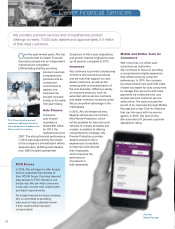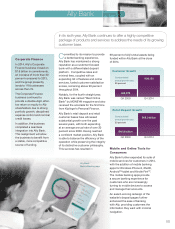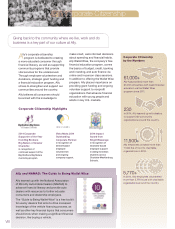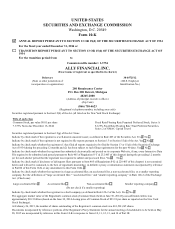Ally Bank 2014 Annual Report Download - page 18
Download and view the complete annual report
Please find page 18 of the 2014 Ally Bank annual report below. You can navigate through the pages in the report by either clicking on the pages listed below, or by using the keyword search tool below to find specific information within the annual report.
Table of Contents
Ally Financial Inc. • Form 10-K
6
guarantee regarding compliance with the plan as a condition of approval of such plan. Failure to meet the capital guidelines could also subject
a banking institution to capital raising requirements.
At December 31, 2014, we were in compliance with our regulatory capital requirements. For an additional discussion of capital adequacy
requirements, refer to Note 21 to the Consolidated Financial Statements.
Mortgage Operations
Our mortgage business is subject to extensive federal, state, and local laws, rules, and regulations, in addition to judicial and
administrative decisions that impose requirements and restrictions on this business. The mortgage business is also subject to examination by
the Federal Housing Commissioner to assure compliance with Federal Housing Administration regulations, policies, and procedures. The
federal, state, and local laws, rules, and regulations to which our mortgage business is subject, among other things, impose licensing
obligations and financial requirements; limit the interest rates, finance charges, and other fees that can be charged; regulate the use of credit
reports and the reporting of credit information; impose underwriting requirements; regulate marketing techniques and practices; require the
safeguarding of nonpublic information about customers; and regulate servicing practices, including the assessment, collection, foreclosure,
claims handling, and investment and interest payments on escrow accounts.
The Dodd-Frank Act imposed new requirements regarding mortgage loan servicing, and the CFPB’s final regulations implementing
these provisions went into effect in January 2014.
The future of the Federal National Mortgage Association (Fannie Mae), the Federal Home Loan Mortgage Corporation (Freddie Mac),
and the Government National Mortgage Association (Ginnie Mae) (collectively, the Government-sponsored Enterprises, or GSEs) and the
role of government agencies in the U.S. mortgage markets remain uncertain. The Executive Branch has committed to work with the Federal
Housing Finance Agency (FHFA) to develop a plan to responsibly reduce the role of the GSEs in the mortgage market and, ultimately, wind
down Fannie Mae and Freddie Mac. In addition, proposals have been introduced in both houses of Congress to reform the role of the GSEs in
the U.S. housing sector and move toward a private sector model.
Automotive Lending Business
The CFPB has focused on the area of automotive finance, particularly with respect to indirect financing arrangements and fair lending
compliance. In March 2013, the CFPB provided guidance about compliance with the fair lending requirements of the Equal Credit
Opportunity Act and its implementing regulations for indirect automotive finance companies that permit dealers to charge annual percentage
rates to consumers in excess of buy rates used by the finance company to calculate the price paid to acquire an assignment of the retail
installment sale contract. In December 2013, Ally Financial Inc. and Ally Bank entered into Consent Orders issued by the CFPB and the U.S.
Department of Justice (DOJ) pertaining to the allegation of disparate impact in the automotive finance business. For further information, refer
to Note 30 to the Consolidated Financial Statements.
Asset-backed Securitizations
Section 941 of the Dodd-Frank Act requires securitizers of different types of asset-backed securitizations, including transactions backed
by residential mortgages, commercial mortgages, and commercial, credit card, and automotive loans, to retain no less than 5% of the credit
risk of the assets being securitized, with an exemption for securitizations that are wholly composed of “qualified residential
mortgages” (QRMs). Federal regulators issued final rules implementing this Dodd-Frank Act requirement in October 2014. The final rules
aligned the definition of QRMs with the CFPB’s definition of “Qualified Mortgage” and also included an exemption for the GSEs’ mortgage-
backed securities (MBS). The regulations took effect on February 23, 2015. Compliance is required with respect to new securitization
transactions backed by residential mortgages beginning December 24, 2015 and with respect to new securitization transactions backed by
other types of assets beginning December 24, 2016. Ally continues to evaluate the final rules and assess their impact on our securitization
activities.
Insurance Companies
Certain of our Insurance operations are subject to certain minimum aggregate capital requirements, net asset and dividend restrictions
under applicable state and foreign insurance laws, and the rules and regulations promulgated by various U.S. and foreign regulatory agencies.
Under various state and foreign insurance regulations, dividend distributions may be made only from statutory unassigned surplus with
approvals required from the regulatory authorities for dividends in excess of certain statutory limitations. Our insurance operations are also
subject to applicable state laws generally governing insurance companies, as well as laws and regulations for products that are not regulated
as insurance, such as vehicle service contracts and guaranteed asset protection waivers.
Investments in Ally
Because Ally Bank is an FDIC-insured bank and Ally and IB Finance are BHCs, acquisitions of our voting stock above certain
thresholds may be subject to regulatory approval or notice under federal or state law. Investors are responsible for ensuring that they do not,
directly or indirectly, acquire shares of our stock in excess of the amount that may be acquired without regulatory approval under the Change
in Bank Control Act, the BHC Act, and Utah state law.
Further, refer to the Tax Assets Protective Measures section of MD&A for details of certain actions taken by us during January 2014,
which are intended to prevent persons from acquiring Ally common stock that exceeds certain ownership thresholds.
























